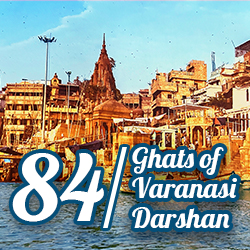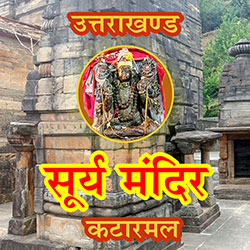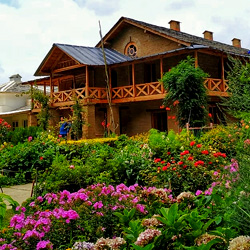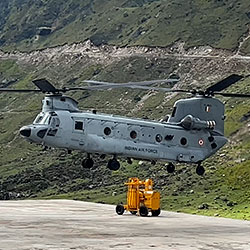
84 ghats of Varanasi
The 84 Ghats of Banaras
The ghats on the great Ganga riverfront at Banaras are unquestionably the city’s most iconic and celebrated image. For thousands of years these ghats have been the centre for religion, culture and commerce, offering an unrivaled panorama for visitors to the city. Today we are going show you complete Ghats journey captured in my last trip.
Note :
- Here we are covering 84 ghats of Banaras and there may be few other ghats as well.
- The onscreen text may not exactly matching with the video but our target to show you beautiful Ghats Journey from river Maa Ganga.
The 84 Ghats of Banaras
- Assi Ghat
Assi Ghat traditionally constitutes the southern end of the conventional city and is the last of the major bathing ghats still to have it’s clay bank. Under a pipal tree close to the bank is an open-air Shiva linga and Hanuman shrine. - Ganga Mahal Ghat
Ganga Mahal Ghat is named after the early 20th century palace of a former maharaja of Banaras which is located at the northern extent of Assi Ghat. - Riva (Rewan) Ghat
This ghat was originally known as Lala Mishir Ghat, and was named after the palace that was built by the family priest of King Ranjit of Punjab. In 1879 it was sold to Maharaja Rivan, and both the palace and the ghat were renamed to Riva. - Tulsi Ghat
Tulsi Ghat named after the great poet Tulsidas (1547-1622 A.D.) who wrote Ramcharitmanas, a translation of the Sanskrit epic Ramayana. - Bhadaini Ghat
Recognisable by it’s tall circular water tower, the huge pumping station here supplies water to the entire city. No bathing or spiritual rituals are performed here. - Janaki Ghat
Originally known as Nagamber Ghat, the ghat we see today was built in 1870 by Maharani Kunwar of Sursand (in Bihar). Janaki is another name for Sita, Ram’s wife. - Anandamayi (Mata Anandami) Ghat
Anandamayi means ‘bliss permeated’, and is the name of a famous woman saint who built an ashram for girls above the ghat. She purchased the ghat from the British in 1944, when it was known as Imalia Ghat. Anandamayi was famous for her ability to heal all kinds of mental and physical ailments, and had the former prime minister Indira Ghandi as one of her followers. - Vachcharaj Ghat
Named after a Jain banker who significantly contributed towards establishing Banaras as a center of trade, Vachcharaj Ghat was built in the late 18th century. Today most of the Jain community of Banaras live near this ghat, which is also believed to be the birthplace of Suparshvanath, the seventh Tirthankar of the Jain tradition. - Jain Ghat
Originally this was part of Vachcharaj ghat immediately to the south but became it’s own ghat in 1931. The southern end is primarily used for bathing, the northern end is where some of the Mallaha (boatman) community live. - Nishadraj (Nishad) Ghat
Originally this ghat was part of Prabhu Ghat immediately to the north until it was split in the early 20th century. The Ghat is named after the mythical chief of the boatmen who helped Ram, Sita and Lakshman cross the river Sarayu in the Ramayana. - Prabhu Ghat
Built in the early 20th century, Prabhu Ghat is named after Maharaja Prabhu Narayan Singh, who ruled Banaras from 1889 to 1931. A popular place for washing clothes, many boatmen families also live here. - Panchkota Ghat
Panchkota Ghat was constructed by the King of Panchakola (Bengal) in the late 1800s. A series of thin stairs from the ghat lead to palatial building where two temples are situated. - Chet Singh Ghat
This ghat is dominated by the imposing palace named after Maharaja Chet Singh, the illegitimate son of the first Maharaja of Banaras, Balwant Singh. Chet Singh managed to secure his succession by over Mahip Narayan Singh by bribing the Nawab of Awadh. - Niranjani Ghat
Originally part of Chet Singh Ghat, a Niranjani Akhara was established here in 1897. - Maha Nirvani Ghat
Named after Mahanirvani sect of Naga Saints, Acharya Kapil Muni of Sankhya philosophy fame lived here during the 7th century A.D. This ghat is believed to be where Lord Buddha once bathed, and nearby is Mother Teresa’s former home. - Shivala Ghat
Shivala means ‘abode of Shiva’, there’s a Shiva temple overlooking the ghat. Te ghat is dominated by a colossal building constructed by the Nepali King Sanjay Vikram Shah. This area is populated by a large south Indian community that came to Banaras over the last two centuries for business and religious purposes. - Gularia Ghat
One of the smallest ghats on the great Ganga, it is named after a huge Gular tree that was once here. - Dandi Ghat
Renovated by Lalooji Agarwal, this ghat is named after the Dandi ascetics who are known for carrying a stick in their hand. They have their own monastery nearby. - Hanuman Ghat
Formally known as Ramesvaram Ghat, Hanuman Ghat is named after the temple here that was built in the 18th century by the great poet Tulsidas. The ghat is also known for the temple of Ruru, the dog form of Bhairav. - Karnataka State Ghat
Built in 1910 by the southern state of Mysore (now Karnataka), the Juna order of ascetics have a monastery and akhara here. There is also a guesthouse run by the government of Karnataka which is open to all but used mostly by visitors from the state. - Harishchandra Ghat
This is one of two cremation ghats of the city which some believe is also the oldest. It is named after a legendary king who once worked the cremation grounds in Kashi. In 1987 an electric crematorium was opened here. - Lali Ghat
Built in 1778 by the Raja of Banaras, this small ghat is dominated by washermen. - Vijayanagaram Ghat
Renovated in 1890 by the Vijayanagaram State of South India, the ghat is overlooked by the Svami Karapatri Asrama and hasshrines of Nilakantha and Nispapesvara. - Kedar Ghat
Kedar Ghat features heavily in the Kedara Khanda of the Skanda Purana, and is home to the Kedareshvara Linga, one of the fourteen most important lingas as designated by the ancient texts. - Chauki (Coawki) Ghat
Built in 1790 and also known as the Buddhist Ghat, it is famous for the huge pipala tree (ficus religiosa) at the top of the steps which shelters a vast array of stone nagas. - Ksemesvara (Somesvara) Ghat
Previously known as Nala Ghat, the ghat we see today was built in the early 18th century. - Manasarovara Ghat
Originally built by Raja Man Singh of Amber in 1585 and renovated in 1805, this ghat is named after the sacred Himalayan lake in Tibet, Manasarovar. - Narada Ghat
Originally known as Kuvai Ghat, Narada ghat is named after the sage best known for the one-stringed Ektara instrument he is always depicted with tucked under his arm. The ghat was constructed by Dattatreya Svami, a monastery chief, in 1788. - Raja Ghat
Formerly known as Amrita Rao Ghat, this ghat was built by Maratha chief Gajirao Balaji in 1720. It was slowly rebuilt with stone slabs between 1780 and 1807. The ghat today is still part of the Amritrao Peshwa Annapurna Trust. - Khori Ghat
Also known as Ganga Mahala Ghat and with no less than five temples overlooking the great Ganga, this ghat was renovated in the late 19th century by Kavindra Narayana Singh. - Pande (Pandey) Ghat
This ghat was named after the famous wrestler of Banaras, Babua Pande, who established an akhara above the steps here. - Sarvesvara Ghat
This small ghat was erected under the patronage of Mathura Pandey in late 18th century. - Digpatia Ghat
The stately palace fronting this ghat, now known as Kashi Ashram, was built in 1830 by the king of Digpatia in Bengal. - Chausathi Ghat
This ghat is named after the temple of 64 goddesses that stands above it, and was shelter to the great Sanskrit scholar, Madhusudana Sarsvati (1540-1623). The temple was renovated by the king of Udaipur (Rajasthan) in 1670. - Rana Mahal Ghat
Forming part of the northern extension to Chausathi Ghat, Rana Mahal Ghat was also built by the king of Udaipur (Rajasthan) in 1670. At the top of the ghat is temple a of Vakratunda Vinayaka. - Darbhanga Ghat
This ghat is dominated by Darbhanga Palace, an imposing structure built by the king of Darbhanga (Bihar) in 1915 along with a nearby Shiva temple. At the top is a shrine of Kukutesvara. - Munsi Ghat
Munsi Ghat was built by Sridhar Narayan Munsi, a finance minister of Nagpur, in 1912. It was an extended part of Darbhanga Ghat which was named in his honour after his death in 1924. - Ahilyabai Ghat
Formally known as Kevelyagiri Ghat, this ghat was greatly renovated by queen Ahilyabai Holkar of Indore in 1778. She is responsible for building several temples in Banaras, including the Amethy Temple on Manikarnika Ghat, and the famous Vishwanath Temple. This was the first ghat to be renamed after a patron of the city. - Sitala Ghat
Renovated by Narayana Diksit in 1740, Sitala Ghat is a northern extension of Dashashwamdh Ghat, and named after the famous Sitala Temple here. - Dashashwamdh Ghat
Centrally located along the string of ghats fronting the great Ganga, Dashashwamdh Ghat is probably the busiest of all the ghats and is often referred to by tourists as “the main ghat”. - Prayag Ghat
It is commonly believed that performing rituals and taking sacred bath here provide exactly the same religious merit as those at Prayaga. The ghat was renovated by the queen of Digpatia state (West Bengal) in the 19th century. - Rajendra Prasad Ghat
Still considered an extension of Dashashwamdh Ghat, it was once known as Ghoda Ghat (Horse Ghat) due to a stone statue of a horse. In 1979 the ghat was renamed in honour of the first president of India. - Man Mandir Ghat
Dominated by the Man Mandir Palace with the astonomical observatory built on the roof, this ghat was formally known as Somesvara Ghat until the Rajput king of Amber, Man Singh, built his palace here in 1585. - Tripurabhairavi Ghat
This ghat is named after the Tripura Bhairavi Shrine, a female partner of Tripuresvara whose image also exists there. The ghat was renovated by the king of Banaras in the late 18th century. - Mira Ghat
This ghat represents two old sites of Jarasandhesvara and Vrdhaditya, which were converted by Mira Rustam Ali in 1735. - Phuta (Naya) Ghat
Previously known as Yajnesvara Ghat, Phuta means “broken” but I’m not sure why the ghat has adopted this name. The site was renovated by Svami Mahesvarananda in mid 19th century. - Nepali Ghat
Named after the distinctive Nepalese Temple that was built by the kings of the Gorkha dynasty in 1902, the whole area is dominated by Nepalese residents. - Lalita Ghat
Famous for two shrines, one dedicated to Vishnu called Ganga Kashev, and the other to Ganga, called Bhagirathi Devi. There is also a shrine of Lalita Devi, it is believed that a glimpse of Lalita Devi brings the same reward as circumambulating the entire world. - Bauli Ghat
Also known as Umaragiri and Amroha Ghat, the original name of this ghat was Raja Rajesvari Ghat. It is thought to have been built in the early 19th century by Babu Kasheva Deva, a rich merchant of Banaras. - Jalashayi Ghat
Jalashayi means “putting dead body into water”, a ritual that is performed prior to the corpse being placed on a log pyre and cremated. This may imply that the ghat once was used for this specific purpose, prior to the cremation occurring at the nearby Manikarnika Ghat. The ghat and associated buildings were constructed in the mid 19th century. - Khirki Ghat
Khirki means “the windows”, which perhaps indicates a place from which cremations on Manikarnika Ghat were witnessed by the funeral party and attendants. Five sati shrines can be seen here, together with a rest house for pilgrims that was built in 1940 by Baldeo Dasa Birla. - Manikarnika Ghat
The most famous ghat in Banaras, where cremations have continuously taken place for probably thousands of years. The first ghat to be renovated in stone, inscriptions from the Gupta period make references to this ghat in the 4th century A.D. - Bajirio Ghat
This ghat and adjacent palace was built by Bajiriao Pesava in 1735. - Scindia Ghat
Formally known as Viresvara Ghat, named after the temple that overlooks the great Ganga here, this ghat was constructed by Ahilabai Holker of Indore in 1780. It has been subjected to a number of repairs and remodelling over the centuries, in 1829 by queen Baijabai, and in 1937 by Daulatarao Scindhia. - Sankata Ghat
Originally known as Yameshvara Ghat after the name of a nearby temple, Sankaha Ghat was built by the king of Baroda (Gujarat) in the late 18th century. In 1825 Beniram Pandit’s widow, known as “Panditain”, and her nephews renovated this ghat and built the temple of Sankata Devi. - Bhonsale Ghat
One of the most beautiful structures to front the great Ganga in Banaras, Bhonsale Palace was built by the Maratha rulers of Nagpur in the late 18th century. - Naya Ghat
Built by the Maratha king Peshwa Amrit Roa, who dedicated this ghat to Ganesh. Naya means ‘new’, and this ghat was one of the main docks of the city. - Ganesha Ghat
Considered an extension to Naya Ghat, it was formally known as Agisvara Ghat but was renamed after the Ganesha temple here. The ghat was renovated between 1761 and 1772 by Madhorao Pesava. - Mehta Ghat
Essentially an extension of Naya and Ganesha Ghat, Metha Ghat became it’s own entity in 1962 and is named after the nearby V.S.Mehta hospital. - Ram Ghat
One of the most popular ghats for bathers, it is named after the small Ram temple to be found here. The famous Sanga Veda School is located near to this ghat. - Jatara Ghat
Jatara Ghat was built by Madhorao Pesava in 1766 as part of the overall renovating of the ghats along this stretch of the great Ganga. - Raja Gwalior Ghat
Also built by Madhorao Pesava in 1766, often Jatara and Raja Gwalior Ghat are considered as just one entity as there is no visible architectural division. - Mangala Gauri (Bala or Lakshmanbala) Ghat
Built by Bajirao Peshwa in 1735, the ghat was later renovated by Lakmana Bala of Gwalior in 1807, which has led to a confusing variety of names for this ghat. - Panchganga Ghat
One of the most sacred sites in Banaras, Panchganga Ghat is believed to be the meeting point of five rivers/streams; the Ganga, Yamuna, Sarasvati, Kirana and Dhupapapa – although today only the great Ganga is visible. - Durga Ghat
Prior to his death in the 1750s, Narayana Diksit, a guru of Pesavas, purchased land from local resident fishermen and built two ghats: Durga and the succeeding one, Brahma Ghat. - Brahma Ghat
Built at the same time as Durga Ghat to the south, Kasi Matha Sansthana monastery is located at the top of the ghat. - Bundi Parakota Ghat
Originally known as Raja Mandira Ghat, this ghat was built by the king of Bundi, Raja Surajana Hada, in 1580. - Shitala Ghat
A contnuation of Bundi Parakota Ghat, this ghat was also constructed by Raja Surajana Hada in 1580. The ghat is named after the goddess of smallpox, whose main temple can be seen on Dashashwamedh Ghat. - Lala Ghat
Lala Ghat was constructed by a rich merchant of Banaras in the early 1800s and is named after him. A small sub-ghat was built in 1935 by Baldeo Das Birla, and is known as Gopi Givinda Ghat. He also constructed a rest house for pilgrims here. - Hanumangarhi Ghat
Representing the famous site of Hanumangarhi in Ayodya, the birthplace of Rama, this ghat is thought to have been founded in the late 19th century. Here can be found a wrestling site (Ganga Akhara) and a sati stone. - Gai (Gaya) Ghat
In the 12th century this Ghat was considered the southern limit of Banaras, as the origins of Kashi actually started further north at Rajghat, where the archaeological remains can still be seen today. Gai Ghat was renovated by Balabai Shitole of Gwalior in the early 19th century. - Badri Narayan Ghat
This ghat was formerly known as Mahatha/Matha ghat, Balabai of Gwalior renovated it in the early 19th century. - Trilochan Ghat
Named after the temple of Trilochan, the three-eyed Shiva, this ghat was a famous site for rituals and bathing during the Gahadavala rule in the 12th century. Renovations occurred prior to 1750 by Narayana Dixsit, and in 1795 by Nathu Bala of Pune (Maharastra). - Gola Ghat
Named after the large number of granaries that once existed here, Gola Ghat was once used as a ferry point going back as far as the 12th century. It’s importance diminished rapidly after the construction of Malviya Bridge in 1887. - Nandikeshvara (Nandu) Ghat
Built in the early 20th century by residents of the local neighbourhood, there is also an Akhara of the same name here. - Sakka Ghat
First documented in the late 18th century, the ghat is mostly occupied by washermen. - Telianala Ghat
Also first documented in the late 18th century, this ghat is most famous for Hiranyagarbha, an ancient sacred site. The ghat is named after the oilpressing caste (Teli) that settled here centuries ago. - Naya (Phuta) Ghat
Originally known as Phuta Ghat and once a sacred waterfront, this whole area was seemingly abandoned in the 18th century and was renamed after renovations. Further renovations took place in 1940 by Narsingh Jaipala Chainput-Bhabhua of Bihar. - Prahlad Ghat
Named after Prahlad, a character in ancient texts celebrated for his devotion to Vishnu, references to this ghat exist in Ghadavala inscriptions from the 12th century. - Rani Ghat
Rani Ghat holds no religious importance and is one of the least popular ghats in Banaras. In 1937 Muniya Sahiba, a queen of Lucknow, built a grand house on the ghat and gradually people started calling it Rani Ghat. - Raja Ghat
Prior to the opening of Malviya Bridge in 1887, Raja Ghat was the most famous and busy ferry ghat in Banaras. Raja Ghat is mentioned numerous times in 11th century Gahadava inscriptions, although this whole area dates back much further than this. - Adi Keshava Ghat
Thought to be the oldest and original site of Lord Vishnu and sometimes referred to as Vedesvara Ghat, this was according to inscriptions the most favourite holy site of the Gahadavala kings. - Namo Ghat
The list of 84 ghats along the Ganga in the holy city of Kashi is all set to get a new addition as with the installation of ‘namaste’ (pair of joined hands) statues in a welcome gesture. Two 25-ft-tall and one smaller ‘namaste’ statues have already been installed at one of the three promenades on the ghat. - Sant Ravidas Ghat
Sant Ravidas Ghat is the southernmost and largest ghat in Varanasi. To most visitors to Varanasi, it is known for being an important religious place for Ravidasis with a 25 acres park known as Sant Ravidas Smarak Park. There is a proposed helium balloon ride facility is at Sant Ravidas Ghat as a tourist attraction.
Key Terms:
- 84 ghat darshan varanasi ,
- 84 ghat varanasi ,
- 84 ghats ,
- 84 ghats of Varanasi ,
- banaras ghat aarti ,
- banaras ghat status ,
- banaras ghats ,
- banarasi saree ,
- famous ghat in varanasi ,
- ghats of varanasi ,
- history of varanasi ,
- manikarnika ghat varanasi ,
- shamshan ghat varanasi ,
- varanasi all ghats ,
- varanasi cinematic ,
- varanasi ghat aarti ,
- varanasi ghat live today ,
- varanasi ghat status ,
- varanasi ghat video ,
- varanasi ghats ,
- varanasi street food ,
- varanasi tourist places ,
- varanasi travel guide ,
- what is varanasi famous for




